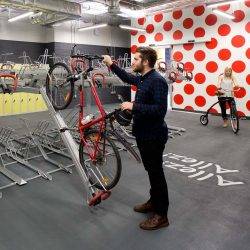July 19, 2017
Link between offices and wellbeing is too important for landlords and occupiers to ignore
 Developers and landlords who invest to create offices that embody the occupier-driven focus on wellbeing will reap their rewards commercially while those that don’t face diminishing returns, according to a new report from Cushman & Wakefield. The Well Workplace report claims to map out the major trends, opportunities and challenges of the future facing owners and occupiers of commercial office space due to the growing emphasis on employee health and vitality as part of the work environment. Improved lighting, layout and use of plants are all known to benefit wellbeing and can increase employee performance. Gains through boosting performance far outweigh potential cost savings through real estate efficiencies – making the imperative for occupiers clear, according to the report’s authors.
Developers and landlords who invest to create offices that embody the occupier-driven focus on wellbeing will reap their rewards commercially while those that don’t face diminishing returns, according to a new report from Cushman & Wakefield. The Well Workplace report claims to map out the major trends, opportunities and challenges of the future facing owners and occupiers of commercial office space due to the growing emphasis on employee health and vitality as part of the work environment. Improved lighting, layout and use of plants are all known to benefit wellbeing and can increase employee performance. Gains through boosting performance far outweigh potential cost savings through real estate efficiencies – making the imperative for occupiers clear, according to the report’s authors.
The report goes on to argue that for landlords there is commercial advantage and price premium for assets which incorporate wellbeing. A survey from the Urban Land Institute revealed two thirds of built environment professionals agree wellbeing features in a property can directly impact market success and economic value. Additionally, more than a quarter of landlords believe they can charge a premium rent as a result of wellbeing, according to a study by Dodge Data & Analytics. The same data shows that nearly half of respondents said spaces leased more quickly.
Report author Sophy Moffat, from Cushman & Wakefield’s EMEA Research & Insight team, said: “The rise of wellbeing in the commercial real estate industry is not a fad but a long-overdue acceptance that people are the largest cost and biggest contributor to the success of companies. The call to action for the real estate industry, and broader built environment, is loud and clear: the design and building of workplaces must change to meet a flexible future.
“Standout examples where wellbeing is already being fully incorporated into buildings, such as the Edge in Amsterdam, are rare. This disconnect between the benefits of a healthy and engaged workforce and office environments which impact wellbeing in negative ways cannot continue. As technology’s rapid advance has impacted the type of jobs people are doing, and the workspaces they require, wellbeing has emerged as a critical issue for the industry because it is simply too fundamental to be ignored. Evidence points to the return on investment available to investors and tenants from differentiation, value creation and risk management. We must now encourage the concept of a broader perspective focused on the total value of the investment and where a workplace culture of work-health balance is the norm.”
James Young, Cushman & Wakefield’s Chair of EMEA Offices, said: “The competition to hire and retain the best people – with companies across all sectors often chasing the same talent – and the known benefits from increased workforce productivity has seen large tech companies at the forefront of workplace developments. We believe the trickle-down effect across the wider industry will become a flood due to a number of factors, chief among them the benefits for the bottom line.”
The report makes three key predictions for how wellbeing will impact the property industry in the future:
1) Wellness officers will proliferate. Human resource and facilities management roles, often operating in corporately-imposed silos, will be superseded by community managers using analytical tools, smart technologies and business metrics to customise the physical environment to its inhabitants. The office as ‘one-space-for-one-organisation’ will be replaced by permeable workplaces with multiple, overlapping communities and a shared level of trust. These workplaces will command a price premium for their functionality and contribution to both occupant wellbeing, as well as business performance.
2) Wellbeing will be critical to attract the highest-quality tenants. Wellbeing will play a key role in leasing decisions, especially for businesses in the knowledge sector. As technology advances, the essentially human parts of work will become more important and gig employees, or swarms, will replace full time employees as the main source of talent. Traditional careers will be replaced by portfolios of experience and employees will choose where and how they want to work. Well, smart offices will therefore become a top priority for top talent and the ‘well’ factor will be imperative to the leasing decisions of leading corporations.
3) Wellbeing metrics will be transformed by technology. Office developers will need to know their consumers better than ever before and space will be developed through early and deep collaboration with occupants. Over the next decade, expect to see workplace wellness programmes predicting sick leave to manage gaps in resourcing, as well as future employee healthcare costs. Also expect analysis of employee health and its attribution to the physical space. Traditional metrics will need to adapt to incorporate advanced insights into patterns of data. Of course, while having individual health data in real time is empowering it also sparks concerns about privacy. If companies have technology to monitor employees’ biometric data and personal health information there are serious, mounting data breaches. In the end, it will be about value exchange – how much will employees be willing to give up to work in better places.














